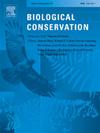Digital footprints of wildlife crime: linking public search behavior to illegal trade dynamics for six keystone mammal taxa in China
IF 4.9
1区 环境科学与生态学
Q1 BIODIVERSITY CONSERVATION
引用次数: 0
Abstract
Wildlife crime poses a severe threat to global biodiversity, driving species extinctions and enabling organized crime networks. While China has strengthened legal frameworks to combat illegal wildlife trade, the shift of illicit activities to online platforms challenges traditional enforcement methods. This study integrates judicial records (2011–2019) with Baidu Search Index (BSI) data to investigate the spatiotemporal dynamics of wildlife crime and its linkage to public search behavior, focusing on six keystone taxa: elephants, rhinos, tigers, bears, pangolins, and musk deer. Using spatial autocorrelation analysis and temporal correlation tests, we assessed how search trends reflect demand-side drivers and crime patterns. Key findings reveal a rise-and-decline trend in wildlife crime and most of the BSI values during the 2010s. Crimes involving exotic species (e.g., elephants, rhinos) clustered in coastal trafficking hubs, while offenses against native taxa (bears, musk deer) dispersed across source regions. Public search behavior exhibited species-specific patterns: derivative products correlated with exotic species crimes, whereas vernacular names aligned with native species offenses, reflecting divergent motivations. Spatial analysis identified High-High crime-search hotspots and demand-supply mismatches. This study pioneers the use of BSI as a real-time proxy for monitoring wildlife crime, demonstrating its utility in pinpointing demand hotspots and informing targeted interventions. Methodologically, integrating digital behavioral data with judicial analytics offers a transformative approach for conservation policy, albeit constrained by semantic ambiguities and rural data gaps. These insights advocate for adaptive, data-driven strategies to curb biodiversity loss and transnational trafficking networks.
野生动物犯罪的数字足迹:将中国六大哺乳动物类群的公共搜索行为与非法贸易动态联系起来
野生动物犯罪对全球生物多样性构成严重威胁,导致物种灭绝,使有组织犯罪网络成为可能。虽然中国已经加强了打击非法野生动物贸易的法律框架,但非法活动向网络平台的转移挑战了传统的执法方法。本研究将2011-2019年的司法记录与百度搜索指数(BSI)数据相结合,以大象、犀牛、老虎、熊、穿山甲和麝6个重点分类群为研究对象,研究野生动物犯罪的时空动态及其与公众搜索行为的联系。利用空间自相关分析和时间相关测试,我们评估了搜索趋势如何反映需求侧驱动因素和犯罪模式。主要研究结果显示,野生动物犯罪和大部分BSI值在2010年代呈上升和下降趋势。涉及外来物种(如大象、犀牛)的犯罪集中在沿海贩运中心,而针对本地物种(熊、麝)的犯罪分散在源头地区。公共搜索行为表现出物种特有的模式:衍生产品与外来物种犯罪相关,而本地物种犯罪与本地名称一致,反映了不同的动机。空间分析确定了高-高犯罪搜索热点和供需不匹配。本研究率先使用BSI作为监测野生动物犯罪的实时代理,展示了其在确定需求热点和告知有针对性的干预措施方面的效用。在方法上,将数字行为数据与司法分析相结合,为保护政策提供了一种变革性的方法,尽管受到语义模糊和农村数据差距的限制。这些见解提倡采用适应性的、数据驱动的战略,以遏制生物多样性丧失和跨国贩运网络。
本文章由计算机程序翻译,如有差异,请以英文原文为准。
求助全文
约1分钟内获得全文
求助全文
来源期刊

Biological Conservation
环境科学-环境科学
CiteScore
10.20
自引率
3.40%
发文量
295
审稿时长
61 days
期刊介绍:
Biological Conservation is an international leading journal in the discipline of conservation biology. The journal publishes articles spanning a diverse range of fields that contribute to the biological, sociological, and economic dimensions of conservation and natural resource management. The primary aim of Biological Conservation is the publication of high-quality papers that advance the science and practice of conservation, or which demonstrate the application of conservation principles for natural resource management and policy. Therefore it will be of interest to a broad international readership.
 求助内容:
求助内容: 应助结果提醒方式:
应助结果提醒方式:


